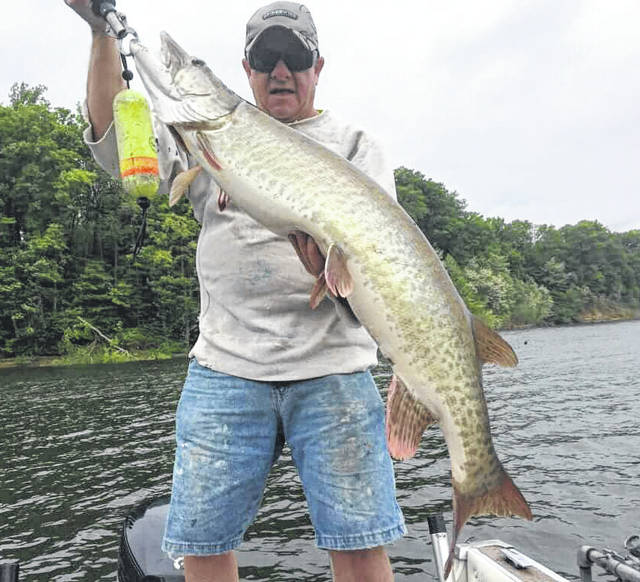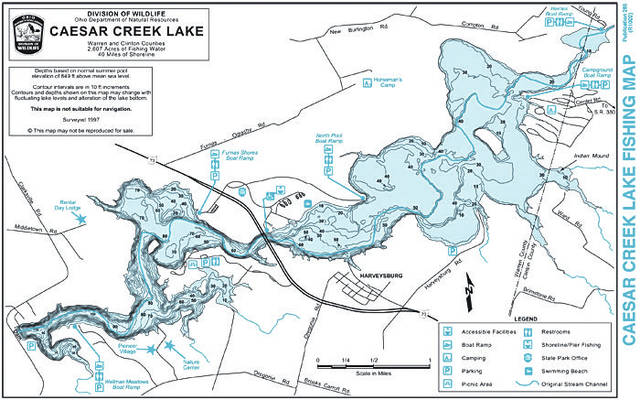


Congress authorized Caesar Creek Lake under the Flood Control Act of 1938. Construction of the dam began in October 1971 and the gates were closed to start filling in January 1978. It encompasses about 2,600 acres at the normal summer pool level. With a depth of 115 feet near the dam, it is the deepest inland lake in Ohio. While under control of the Louisville District of the U.S. Army Corps of Engineers, the Division of Wildlife provides resource management of the fishery and wildlife area.
Five boat ramps offer convenient access around the lake. The Wellman Prairie Ramp at the south end near the dam is a favorite of fishermen. It is in a no wake area that makes loading a boat easier. Parking is ample although there are no pull-through spots. The ramp at the campground is great when fishing the northern part. Many maps still show the Haines Road boat ramp on the northwest side of the lake. Haines Road has been renamed Young Road so some map and GPS confusion may result. It provides access to the river at the north end.
The North Pool boat is often very busy. The waves and boat traffic can make loading the boat a little tricky here. The Furnas Road ramp is steep but very convenient to the lake’s middle area.
The lake offers a variety of fish structure from the creek tributaries to steep shores and into the deeper water at the southern end of the lake. There are plenty of gravel and sandy areas that form small bays around the lake. The coves still have a large number of standing timber and brush. Fishermen should use caution as many trees have now rotted off just below the water’s surface. Caution should also be used in the spring following heavy rains as there will often be debris in the lake. A quality lake map plus electronic equipment will provide a significant aid in both navigation and locating fish. Older county maps showing the roads before the lake was built are a good source for locating the road beds for some “hidden” structure.
Crappie fishing is especially good in the spring during the spawn. The crappie will be in the abundant tree tops and brush lines that dot the lake. Division of Wildlife creel surveys indicate that the crappie catch rate has been steadily improving with 2017 the best year since 2005. Fishermen should pay particular attention to the buoys and their depth-finder as Jonas Run area has some especially shallow areas. My favorite crappie tactic for late spring and summer is trolling Shad Rap lures up to 15-feet deep along the various points and shelves on the edge of deeper water. This technique often produces larger crappie.
The Division of Wildlife reports that Caesar Creek is currently ranked fourth in the state for numbers of white bass. The surveys indicate a good population of 8 to 11-inch white bass with a fair number ranging up to about 14-inches. I often catch white bass while trolling the smaller crank baits for crappie.
Largemouth bass are also found throughout the lake. The Division of Wildlife conducted electro-fishing surveys for Largemouth bass in 2016. The results show continued improvement in the bass population with more than half of the netted fish being 12-inches or greater. The reported bass angler catch rates in 2012 were the best in several years. There are also good numbers of channel cats with some in the eight pound or more range. Channel catfish caught during 2017 netting surveys averaged 19 inches with fish up to 31 inches. Many cat fishermen target the northern end of the lake above the Young Road boat ramp and into the tributaries
A significant success story for Caesar Creek Lake is the continued growth of the saugeye and Muskie fisheries. Both species have been intensely managed and stocked by the Division of Wildlife. There have been more than 6.6 million saugeye fingerlings stocked between 2000 and 2012.
Muskie fishing is the hot topic and causing quite a splash at Caesar Creek. The stocking program began in 1998 but it was about 10 years before muskie were noticed by fishermen. Between 2,800 and 5,600 advanced fingerling muskie from the Kincaid Fish Hatchery have been stocked each year over the last five years.
Local fisherman and retired outdoor radio show host Calvin Pyle grew up in the area that is now covered by Caesar Creek lake. Pyle has fished the lake since it was formed.
He notes that over the years he’s had some great fishing trips there, “It is a big lake with all the various coves to learn. The lake is also deep so the water temperature, especially in the spring, will vary a lot from the shallower north end to the deep south end by the dam … I like to use the older maps that show the original ponds, housing foundations and road beds to learn some hidden structure. A map I really recommend is still available at the Tackle Town Bait store.”
Fishermen all have their favorite locations on the lake depending on the season and the species targeted. Some will be seen running the lake hunting for fish. It is common to encounter fishermen targeting the different species in the same areas. During the fall and winter months, the lake level is lowered to prepare for the storage of heavy spring rainfall. Lake level and water flow information is found online at the US Army Corps of Engineers Louisville District.




